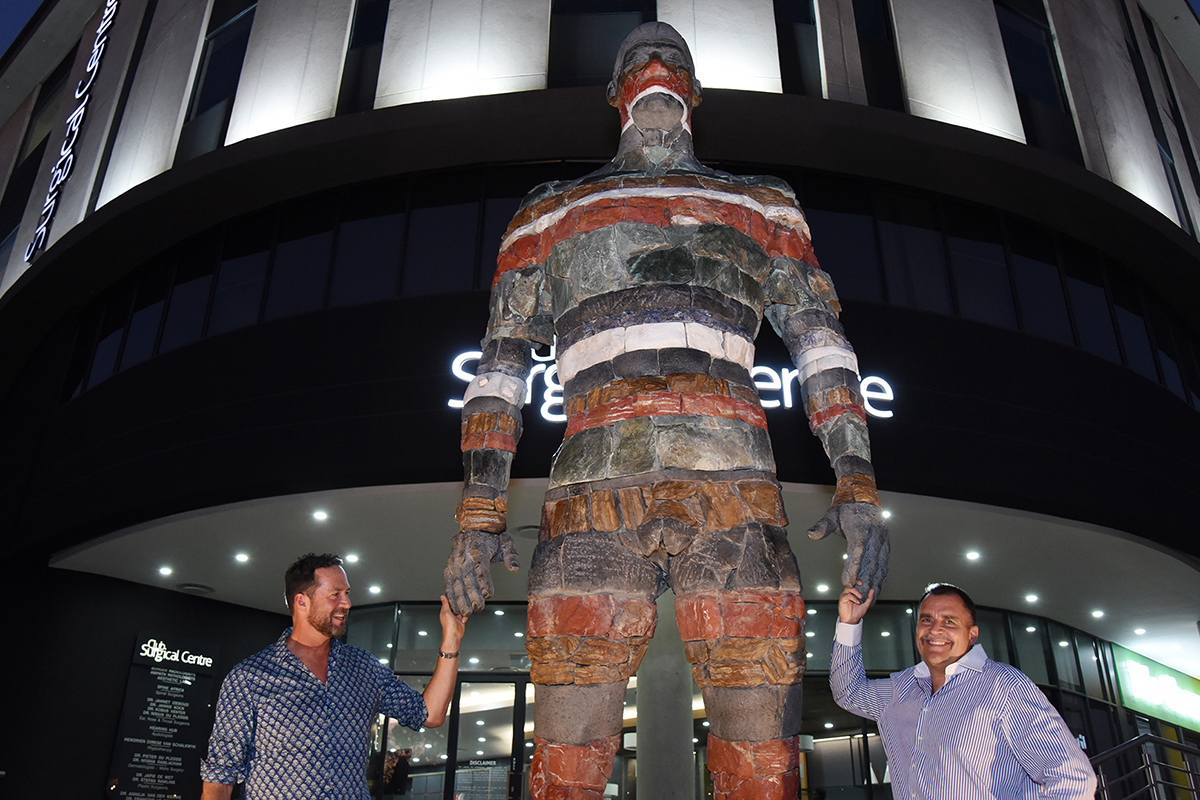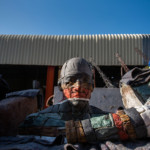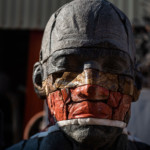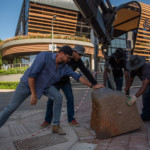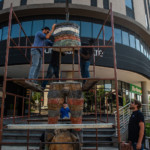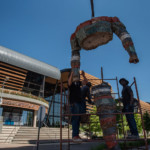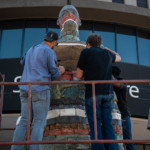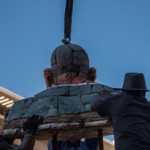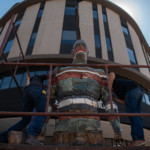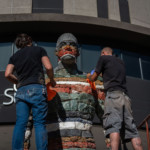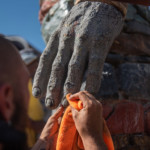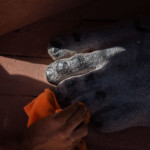As you approach Atterbury’s head office Die Klubhuis in Pretoria, you will see him, standing across the road, contemplating the world; his massive bulk rising three times the height of a human above the pavement that he seems to have grown from. He is the “Son of the soil – kinders van hierdie klippe”, and he was created from African rock dating back billions of years. Sculptor Angus Taylor told us all about his latest public artwork.
Some years ago, I began a composite portrait study based on the general measurements and characteristics of the people that help me create my work. This portrait is still in development and continues to evolve with every new sculpture I make.
In the film industry, every contributor – including the tea lady – is acknowledged, but fine art is attributed to the lone genius in the studio. With sculpture specifically, that is not the case. Perhaps because I grew up in Africa, I lean slightly more towards a collective culture than a pure individualistic approach. As the African saying goes: Motho ke motho ka batho babang (a person is a person because of other people). I am because of the team that I work with (and they, because of me).
The portrait therefore represents the collective of people who comprise my DSW studio (established in 1996), all of whom reside in and around Pretoria. Over the last two decades we have contributed significantly to the region’s public art wealth, all made possible through the support of patrons.
Public art can be a gift to the community, if considered correctly. When created as propaganda for the state or political ideologies or church, it can fail. Art speaks. It can say or do something profound if it is visually legible.
Although “Son of the soil” has layers of meaning and multiple dimensions of thought invested in its being, the work remains open-ended, to be completed by the viewer’s interpretation.
I will, however, name a few of the thoughts that led to its being.
Geology, to me, is the understanding of the tangible markers and its narratives within deep time. The stories one can extrapolate from a chunk of stone are remarkable – for instance, a 3.6 billion-year-old piece of hardened ancient beach, which existed when the moon completed its cycle in 15 days instead of the current 28 days. It was there when very little land mass and light existed, and nothing with cellular complexity lived. There was almost no oxygen. Yet here you are holding in your hand this ancient beach, which as a thought, to me, is incredible. This piece of stone, without deeper understanding, is just a rock. But knowing that it is a thousand times older than you as a hominid is humbling.
I do not find this to enhance nihilism in thought. I find it inspiring, as if the stone is saying, “You have this short moment within the context of time, a gift… what will you do with it?” Will it be a self-serving, ego-based, competitive drive for relevance, or an engagement with being on another level?
In your moment, you can achieve meaning by positively transforming your world for the better. The engagement can be through relationships, people, ideas or the interaction with your physical world and its materials. One can aim to convey ideas that need spreading, grow understanding that will help others and yourself, or aim to inspire bettering by doing your utmost best.
The sculpture is large and can be intimidating, but hopefully has a calming effect – contemplative and standing in absorption – which allows the viewer to do the same. Another layer of strata is that it will hopefully, with calm conviction, express the beauty of what we take for granted: the earth we walk on, the soil we dig into to plant a tree, or lay a foundation for building, or bury someone. We are because the soil is – a simple fact, but we seem to forget that if we mess with it (through fracking, for instance), everything on the surface can be lost.
Because the stone is, the specific soil can be, therefore the specific plants can grow, therefore specific animals can feed, and therefore we can be. The stone is life’s foundation of being.
The stones used in “Son of the soil” are mostly harder than seven on the Mohs Scale of Hardness. To give context, whereas marble and concrete read four on the Mohs scale, the Gabbro (commonly referred to as Belfast granite) read a seven, but the Red Jasper and Tiger’s Eye at nine. Diamonds read 10 on the Mohs scale. Dis dus nie vir sissies nie.
Another layer of meaning relates to stone being a tangible, undisputable truth. That which is, is. Again, it might sound basic, but consider the following:
In 2016, the Oxford Dictionary word of the year was “post-truth”. To me, this is quite unnerving. If one studies a chunk of stone, the minerals, the composition, its surroundings, its age, so much information can be understood from it. These facts contribute to a world of wisdom, of truths. This stands in opposition to opinion or collective perception that might or might not be built on any facts. Stone can literally ground your thinking, give a foundation and context to your understanding. For society today, this is very healthy and necessary.
Another layer refers to a complex array of nuances; the stone as metaphor for being as a whole. Life is complex and ambiguous. Within its enigmatic nature lies a wealth of beauty. However, if one simplifies this wealth and complexity into simple sets of binaries, it can easily become bland and poor. Life cannot be reduced to only black and white, oppressed and oppressor, African or Western, happy or sad.
The rich diversity of being, is visually laid bare by just a study of some of Southern Africa’s natural stone colours – rocks are not just brown.
To name but a few of the stones that were used to make this sculpture:
Belfast Gabbro, which is two billion years old, is from the largest simmering bubble of stone on earth, the Bushveld Igneous Complex. The beautiful, extremely hard Red Jasper is from Griekwastad-West. The green stone forms part of the ancient greenstone belt from Barberton (although one should mention ancient green stone is not necessarily green in colour). Verdite, as it is called, is 3.5 billion years old. The white marble is from the Southern African region, Namibia.
For continuity I repeated layers, but each layer could easily have been from a different colour of stone.
The method I used to make the sculpture is somewhat complicated, but in short:
First, I made a half-scale model by sculpting it in clay. For the detailed aspects on the larger sculpture, I used the same process: the arms, feet and bust were also modelled in clay. The simple shapes, torso and legs were digitally up-scaled by laser-cutting a steel frame. Over the large clay sections, a steel frame was welded that could be disassembled. Joining the digital laser-cut frame and the welded frame created the mould. Within the mould we built and carved the sculpture as a layer of stone. Each piece was drilled and pinned with steel on the inside to a steel structure. This is an engineered interlocking internal steel structure that disassembles in five layers for transport purposes. The inside was solidified with a castable material. Including the scale model and the making of the steel frame mould, the sculpture took 16 months to make. The stone work alone took nine months to complete.
To be able to push the sculpture forward in composition, so to activate the space better, we attempted to make it as light as possible. However, the head and shoulders alone weigh 530kg. Above ground the sculpture weights more than four tons.
This specific sculpture forms part of a larger body of work where I focus on our local natural material.
The very first sculptural “form” we as humans made, was a heap of stone. It was used to mark an important place in our environment and has existed in the human cultures where one stone was available for thousands of years. The idea that a heap of stone was the oldest way to make something, seemed profound and challenging to me. To model in clay and cast in bronze makes a sculpture both “grand” and remarkable due to what I describe as “magical alchemy”, turning metal to liquid and the liquid metal into your sculpture. A stone pile is harder to fashion into something memorable.
Over the last decade I systematically started carving details into my heaps and slowly my assistants and I became more proficient at it.
It remains humbling and I feel tremendously privileged to be able to work with a material that is around half the age of the earth… which was born 4.6 billion years before the present time. As the stone already was something before I started to work with it, the work becomes an active collaboration between myself, my assistants and the material. Stone has a profound is-ness or “Tsu-jan”. Through respectful understanding of this is-ness, you can achieve great things together.
Public art is my greatest interest within my practice. I see it as a gift to the wider community, not only the cultured select few that frequent galleries and museums. If correctly approached and executed, public art becomes part of the community’s heritage, culture and wealth.
Any artist worth his or her salt will never be completely content with the end result of an artwork. The endeavour of making, asks of the maker to always move away and try harder, to do better. During the course of a year one has hopefully been able to grow, learnt to see sharper, understood more and understood better, and therefore one can try one’s utmost with the next sculpture. I am grateful for the opportunity to give our best. Without the commission, due to its scale, it would not have been possible. The work seems to be accepted with gratitude by the community who has embraced it, and that makes me happy.



